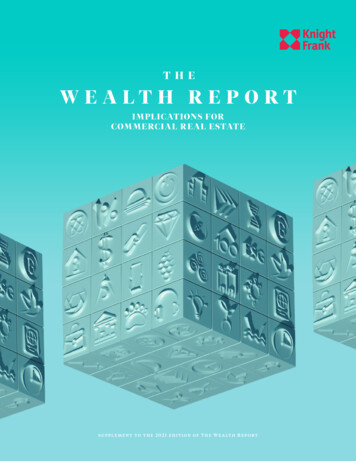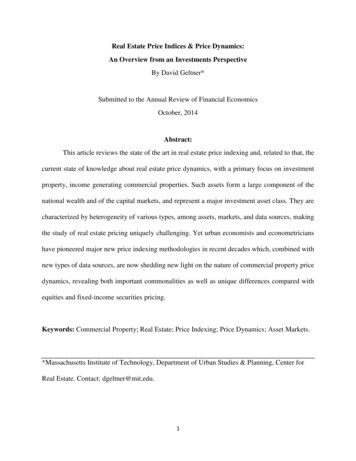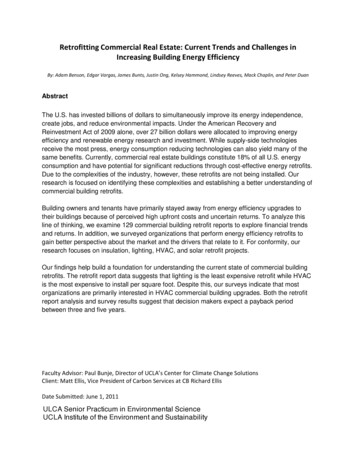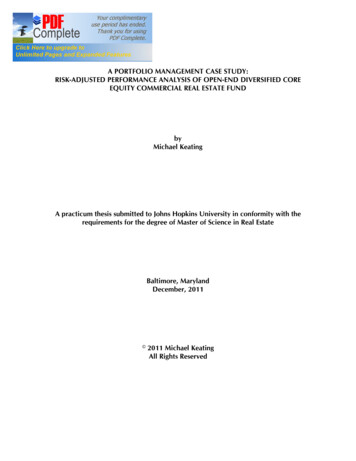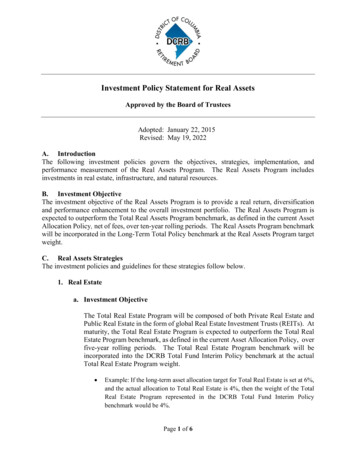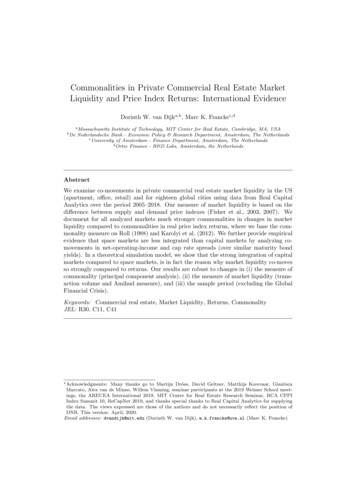
Transcription
Commonalities in Private Commercial Real Estate MarketLiquidity and Price Index Returns: International EvidenceDorinth W. van Dijka,b , Marc K. Franckec,da Massachusettsb DeInstitute of Technology, MIT Center for Real Estate, Cambridge, MA, USANederlandsche Bank - Economic Policy & Research Department, Amsterdam, The Netherlandsc University of Amsterdam - Finance Department, Amsterdam, The Netherlandsd Ortec Finance - R&D Labs, Amsterdam, the NetherlandsAbstractWe examine co-movements in private commercial real estate market liquidity in the US(apartment, office, retail) and for eighteen global cities using data from Real CapitalAnalytics over the period 2005–2018. Our measure of market liquidity is based on thedifference between supply and demand price indexes (Fisher et al., 2003, 2007). Wedocument for all analyzed markets much stronger commonalities in changes in marketliquidity compared to commonalities in real price index returns, where we base the commonality measure on Roll (1988) and Karolyi et al. (2012). We further provide empiricalevidence that space markets are less integrated than capital markets by analyzing comovements in net-operating-income and cap rate spreads (over similar maturity bondyields). In a theoretical simulation model, we show that the strong integration of capitalmarkets compared to space markets, is in fact the reason why market liquidity co-movesso strongly compared to returns. Our results are robust to changes in (i) the measure ofcommonality (principal component analysis), (ii) the measure of market liquidity (transaction volume and Amihud measure), and (iii) the sample period (excluding the GlobalFinancial Crisis).Keywords: Commercial real estate, Market Liquidity, Returns, CommonalityJEL: R30, C11, C41? Acknowledgments:Many thanks go to Martijn Dröes, David Geltner, Matthijs Korevaar, GianlucaMarcato, Alex van de Minne, Willem Vlaming, seminar participants at the 2019 Weimer School meetings, the AREUEA International 2019, MIT Center for Real Estate Research Seminar, RCA CPPIIndex Summit 10, ReCapNet 2019, and thanks special thanks to Real Capital Analytics for supplyingthe data. The views expressed are those of the authors and do not necessarily reflect the position ofDNB. This version: April, 2020.Email addresses: dvandijk@mit.edu (Dorinth W. van Dijk), m.k.francke@uva.nl (Marc K. Francke)
1. Motivation and research questionsMarket liquidity – the ease of trading a property – and asset prices in real estate marketsmove together, which implies that changes in market liquidity tend to be pro-cyclical tochanges in asset prices. This holds for commercial real estate markets (see for exampleFisher et al., 2003; Clayton et al., 2008) as well as for residential real estate markets (seefor example Goetzmann and Peng, 2006; De Wit et al., 2013). This paper compares forprivate commercial real estate asset markets commonalities in market liquidity changes tocommonalities in price index returns. We analyze within-country as well as internationalco-movements.Commonalities in market liquidity are in particular relevant for large investors indirect commercial real estate, such as pension funds and other institutional investors.Investors do not only face price risk, but also the risk of illiquidity, the uncertain timeit takes to sell properties (Cheng et al., 2010, 2013). Depending on the degree of commonality in segments (for example apartments, offices, retail, and industrial) and regionswithin national and international markets it might be possible to diversify liquidity riskin their portfolio.Several market liquidity metrics exist, relating to different dimensions of liquidity,such as transaction volume, turnover ratio, Amihud measure (Amihud, 2002), time-onthe-market, and trading frequency. For an extensive overview and discussion of liquiditymeasures we refer to Ametefe et al. (2016). In this paper we use as a measure formarket liquidity the difference between supply and demand price indexes related to astandard price index, following Fisher et al. (2003, 2007) and Clayton et al. (2008). Weuse the method of Van Dijk et al. (2020), who derive supply and demand indexes in arepeat sales model framework. This approach has the advantage of effectively dealingwith heterogeneity in commercial real estate assets without the need for many propertycharacteristics or assessed values. Moreover, by using Bayesian techniques the supplyand demand indexes can be robustly estimated in small samples.Commonalities in private real estate market returns have been extensively researched.For example, Srivatsa and Lee (2012) examine the convergence of yields and rents ofEuropean offices markets, MacGregor and Schwann (2003) find common cycles in UKcommercial real estate returns, and Van de Minne et al. (2018) find two common factorsthat summarize the variation in price index returns for 80 non-overlapping US commercialreal estate markets. Clark and Coggin (2009) provide evidence of commonalities in UShousing returns and Holly et al. (2011) look at the relationship between London, otherUK, and New York housing returns.The literature on commonalities in real estate market liquidity is much smaller. Thecommonality between returns and stock market liquidity risk for listed real estate hasbeen examined by Hoesli et al. (2017). The authors find that commonalities in stockmarket liquidity result in risk factors for REIT returns, but that this only holds in badtimes. Brounen et al. (2019) study the relation between liquidity and price returns in international listed real estate markets. They find wide variations across ten markets usingfour different liquidity measures (trading volume, stock turnover, Amihud measure andthe number of zero return days). Moreover, they document evidence for internationaltrend-chasing behavior. Most of the studies on private commercial real estate marketliquidity analyze the dynamics of liquidity measures in just one market (for exampleFisher et al., 2003, 2007; Clayton et al., 2008; Wiley, 2017). There are a few exceptions.2
Ling et al. (2009) study the price dynamics and transaction activity for ten segments inprivate commercial real estate in the UK over the period 1987–2007. They find a statistically significant positive relationship between lagged turnover and contemporaneouscapital returns. Devaney et al. (2017) study determinants of variations in transactionactivity for a set of 49 US MSA office markets in the period 2002–2015. Van Dijk et al.(2020) note that for the US market liquidity movements tend to be stronger correlatedacross markets than price movements.We add to the real estate literature by documenting commonalities in market liquidity,and price index returns for several private commercial real estate asset markets: 25 largeUS markets, the 6 largest US markets subdivided by sector (office, retail, and apartment),and 18 global gateway markets. We show empirically by using transaction data from RealCapital Analytics in the period from 2005Q1 to 2018Q4, that co-movements in marketliquidity changes are much stronger than co-movements in price index real returns. Wefollow the method applied by Roll (1988) and Karolyi et al. (2012), a R2 -based method,to measure the degree of commonality.In order to justify the use of our empirical commonality measure and to understandthe difference in commonality between liquidity changes and price index returns, wepresent simulation results from a theoretical “cap rate” model. We allow the differentcomponents, net-operating income, risk-free rate, risk premium and growth expectations,to co-move differently across markets. Moreover, we allow buyers and sellers to have different views on these components. We show which assumptions are required to generatestronger co-movements in market liquidity changes compared to price index returns.First, the cross-market co-movement in the risk premium component (determined bycapital markets) needs to be stronger than the cross-market co-movement in rents (determined by space markets). We provide empirical evidence for this assumption by showingthat space markets are less integrated than capital markets by analyzing co-movements innet-operating-income and cap rate spreads (over similar maturity bond yields). Second,sellers need to lag buyers “sufficiently” in their perception of risk premium comparedto net-operating-income. The second assumption relates to “loss aversion” or anchoring(Bokhari and Geltner, 2011). The seller bought the property some time ago against thefinancing conditions that prevailed at that time. Hence, it is reasonable to assume thatthe current perception about financing conditions is a function of past financing conditions that applied to the property in question. Also, information asymmetries mightplay a role here, were sellers are not able to “digest” all possible market informationinstantaneously (Carrillo et al., 2015; Van Dijk and Francke, 2018).In summary, we pose three questions related to private real estate asset markets:(i) “How strong is the co-movement in changes in market liquidity?”(ii) “How strong is the co-movement in real price index returns?”(iii) “Which factors drive the difference in commonality between market liquidity changesand real price index returns?”The paper proceeds as follows. Section 2 provides details on the construction of market liquidity and commonality measures. Section 3 provides simulation results to justifythe use of our empirical commonality measure and to understand the difference in commonality between liquidity and price. Section 4 gives the data description, documentingper market summary statistics on price index returns and changes in market liquidity.3
Section 5 shows the degree of empirical commonality in both market liquidity changesand price index returns. In addition, this section shows degrees of integration for netoperating-income and risk premia. Section 6 provides results from three different robustness checks: (i) an alternative commonality measure by principal components, (ii) twoalternative market liquidity measures: transaction volume and the Amihud measure,(iii) excluding the effect of the Global Financial Crisis. Finally, Section 7 concludes.2. Methodology2.1. Price index returns in real estateFundamentally, space market as well as capital market characteristics should be reflectedin the price of real estate. We can express the prices in the celebrated “cap rate” modelas follows1 :Pi,j,t N OIi,j,t,RFi,t RSPi,j,t Gi,j,t(1)where subscript i, j and t denote a market, property and time-period, respectively. N OIis the net operating income of the property, G the prospective growth rate, RF therisk-free rate, and RSP the risk premium. Rewriting Equation (1) in logs yields:pi,j,t noii,j,t log(RFi,t RSPi,j,t Gi,j,t ),(2)where the lowercase variables are the log-transformed uppercase variables. Property levelprice (capital) returns can be obtained by rewriting the log-model in first differences: pi,j,t noii,j,t log(RFi,t RSPi,j,t Gi,j,t ).(3)This equation implies that price returns in market i for period t are dependent on changesin both capital market variables (RF , RSP ) and space market variables (noi, G).Price indexes could be derived from a model that includes both local market conditions and property characteristics (time-invariant property characteristics cancel out ina repeat-sales setting):pi,j,t βi,t x0i,j α εi,j,t ,(4) pi,j,t βi,t εi,j,t ,(5)where xi,j is a K-dimensional vector of time-invariant property characteristics with corresponding coefficient vector α, and ε is an independent normally distributed error termwith mean zero. βi,t ( βi,t ) is the common log price index (return) for market i at timet. These common trends are the market-wide developments in prices. Relating this tothe fundamental price Equation (3), these trends reflect market-wide trends in risk-freerates, risk premia, and NOI growth rates. The property characteristics usually captureproperty-specific variables, such as location, size, maintenance, parking facilities etc.1A“cap rate model” provides the value of a property based on income discounted into perpetuity, similarto a Gordon Growth Model in stock valuation.4
Returning to our research question on commonalities, it is straightforward to see thatcommonalities in index returns across different markets (i.e. the co-movement in βi,tacross different i) will be determined by the commonalities in changes of the separatecomponents of Equation (3). The N OI and growth rate (G) are more likely to be determined by space markets, whereas the risk-free rate (RF ) and the risk-premium (RSP )tend to be determined more by capital markets. Space markets are determined by localcharacteristics and capital markets tend to be nationally or even internationally integrated. Even though space markets may co-move across markets as well, it is reasonableto assume that this holds to a larger extent for capital markets. This is something wewill assume in our theoretical simulation and will back-up empirically later on.2.2. Market liquidity in real estate marketsIn order to introduce our concept of market liquidity, we begin by disentangling thepricing Equation (5) into buyer and seller components.2 Doing so, we get somethingcommonly referred to in the literature as reservation prices of buyers and sellers (Fisheret al., 2003):bbrpbi,t noibi,t log(RFi,t RSPi,t Gbi,t ),(6)rpsi,t(7) noisi,t slog(RFi,t sRSPi,t Gsi,t ),where rp denote (log) reservation prices. Superscripts b and s denote buyers and sellers,respectively. The other symbols are equivalent as discussed in the previous section. Notethat buyers and sellers might have different perspectives on income, prospective growthrate, risk premium, and the risk-free rate.3 Again, we can reformulate Equations (6)–(7)in a linear model:brpbi,t βi,t x0i αb εbi,t ,rpsi,t sβi,t x0i αs (8)εsi,t .(9)In this case, βtb and βts are common trends across the reservation prices of all buyersand sellers, respectively. These common trends are the market-wide developments of thecentral tendencies of buyers’ and sellers’ reservation prices.Reservation prices, however, are latent unobserved variables that are not readilyavailable. Fisher et al. (2003, 2007) develop a method to disentangle buyers’ and sellers’reservation prices from transactions data. Van Dijk et al. (2020) extend this methodin a repeat sales and structural time-series framework such that the method can beapplied on most transaction data-sets on a regional scale. Van Dijk et al. (2020) furtherpropose a metric for market liquidity based on the difference of buyers’ and sellers’reservation prices. To answer our question on commonalities, we use this method toconstruct demand and supply reservation price indexes as well as liquidity indexes on aregional scale. The model assumes that heterogeneous properties trade in a double-sidedsearch market. Buyers and sellers base their valuation of a given property (reservation2 Fromnow on we omit subscript j to simplify notation.the model does not assumes this a priori, there should be a single risk-free rate for everyoneas we will assume later in our theoretical simulation.3 Although5
prices) on observable property characteristics. In this model, we observe a transaction ifrpbi,t rpsi,t .Assuming equal bargaining power from either the buyer or seller side, the averageasset price valuation βt that we measure in general in price indexes per Equation (5) ishalfway in-between buyers’ and sellers’ reservation price:βi,t bsβi,t βi,t.2(10)Following Fisher et al. (2003), the indexes are transformed such that the mean of thebuyers’, sellers’, and midpoint price indexes is equal. We start the log price index at anarbitrary value of 1.4 By looking at the difference between buyers’ and sellers’ reservationprice indexes, we are able to construct a liquidity metric. The liquidity metric canbe interpreted as the increase in buyers’ reservation prices the decrease in sellers’reservation prices as a percent of the current prevailing consummated transaction pricethat would bring the market to long-run average liquidity. In that case the liquiditymetric would be equal to 0. The metric for a given market i at time t is defined as:bsLiqi,t (βi,t βi,t) βi,t .(11)bsThe term βi,t βi,tdenotes the time trend of the probability of sale per period, keepingconstant the included property characteristics. The components of the liquidity metriccan be estimated by a two-step approach (Heckman, 1979) using a probit model tobsestimate βi,t βi,tand an adjusted linear regression model to estimate βi,t . For a moreelaborate description of the variables, the model, and estimation procedure we referto Van Dijk et al. (2020). The liquidity metric is theoretically and empirically closelyrelated to other liquidity metrics based on for example the time-on-market in housingor the turnover rate (Van Dijk, 2018). The difference being mainly that this liquiditymetric is quantified in the price dimension, relative to the currently prevailing price level.Because the price and liquidity metrics are estimated for regional markets for whichsometimes few transactions are available (the markets are said to have thin data), we estimate the price and liquidity indexes in a structural time-series framework to efficientlydistinguish between signal and noise. The repeat-sales price index returns are assumedto follow a first-order autoregressive process. For more information on the smoothingprocedures, see Van Dijk et al. (2020).5 We further recognize that the literature sometimes uses different market liquidity metrics. Therefore, we have devoted a robustnesscheck that uses two alternative measures of market liquidity (transaction volume and theAmihud measure, see Section 6.2).If we return to our fundamental pricing equations of buyers’ and sellers’ reservationprices (Equations 6–7), this has implications for what will be reflected in the price in4 Note5that, as with all indexes, βt represents the relative longitudinal change over time.We do recognize that the metrics are smoothed in a different way and that this could potentiallyinfluence the integration metrics that we will discuss in the next section. However, by looking atthe empirical results, it is clear that the price indexes are much smoother than the liquidity indexes.Because the liquidity indexes will contain more noise, this favors the integration of returns comparedto changes in liquidity. This implies that our results on the integration of liquidity are probably on theconservative side.6
dex (βi,t ) and in the liquidity metric (Liqi,t ). Price index returns essentially reflect theaverage of buyers’ and sellers’ changes in valuations. The market liquidity metric, however, is the difference between the valuations of buyers and sellers. As a consequence,common valuation of characteristics common to both buyers and sellers will cancel out.The remaining liquidity metric should thus reflect the characteristics that are differenton differently valued to buyers and sellers. It is not straightforward to answer whetherspace or capital market characteristics cancel out in this case. We will show in a simulation framework in Section 3 that, with minimal assumptions, it will be mostly the spacemarket components that will be cancelled out. Hence, changes in the liquidity metricwill mostly reflect changes in the capital market components.2.3. Measuring commonalityWe employ two different measures for the commonality in market liquidity and returns.First, we use measures frequently applied in stock market research. More specifically, wemodel regional market returns on national (aggregate) market returns. See Roll (1988)and Morck et al. (2000) for stock return applications and Karolyi et al. (2012) for a stockmarket liquidity application. The regional real market index return ri,t for regionalmarket i in period t can be expressed as: i Retri,t αiRet rm,tβi εReti,t ,(12) iwhere rm,tis the aggregate real market capital return for each country-asset class combination m (e.g. US commercial real estate, global gateway commercial real estate, USoffice etc.) in period t, excluding regional market i to prevent for simultaneity bias.We calculate the aggregate market capital return by taking the weighted (by the totalnumber of transactions apart from regional market i over the whole sample) averagereturn for each country-asset class combination. The commonality measure is the R2of Equation (12). The degree of integration for each country-asset class combination iscalculated by the average R2 of all regional markets within this combination. Note thatwe use real returns in order to prevent that common movements in inflation are capturedby the R2 -measure.In order to determine the commonality in market liquidity we adapt the approach byKarolyi et al. (2012). We first filter per regional market i the liquidity by the followingtime series model:LiqLiqi,t aLiqi Liqi,t 1 Dτ ωi,t .(13)Here, Liq is the estimated liquidity metric from Equation (11), Dτ are seasonal dummyvariables. Following Karolyi et al. (2012) we include lagged liquidity in these filteringequations, such that we essentially take (cleaned) periodic innovations in liquidity.6 WeLiquse the residuals ω̂i,tto obtain measures of commonality in real estate market liquidity6 Weacknowledge that this will result in a higher R2 . The main results, however, still hold withoutincluding lags and leads in the liquidity regressions. Likewise, the results also hold when includingleads and lags in the return equations. We opt to present our main analysis with leads and lags in theliquidity regression only to remain consistent with the literature.7
for each regional market i by calculating the R2 from the following model:Liqω̂i,t αiLiq 1XLiq, i Liqω̂m,t jβi,j εLiqi,t .(14)j 1Liq, iHere, ω̂m,tdenotes the weighted (again by the total number of transactions apart fromregional market i over the whole sample) aggregate market residual from Equation (13)for country-asset class combination m, again excluding regional market i in calculatingthe aggregate market residual. Following Chordia et al. (2000) and Karolyi et al. (2012)we include one lead and lag of aggregate market liquidity in order to capture any laggedadjustment in commonality.In order to provide explanation of our results, we will also run a similar integrationanalysis on NOI and cap rates. We will determine the degree of integration of NOI andrisk premia (cap rate spreads) by the return Equation (12). Hence, in this case we have:ri,t { noi, RSP }. We recognize that that risk premia and cap rate spreads are notthe same because cap rate spreads will also include the growth component. However, forour purposes it is sufficient if the level of the risk premium is larger than the level of thegrowth rate. This is generally the case because we observe positive cap rate spreads. Seealso Section 3.Because the above regressions from Equation (12) are essentially CAPM regressions,concerns may arise regarding the applicability of the CAPM to private real estate assets.For example, real estate is not solely an investment good and we already take regionalmarket returns as “individual” returns. Additionally, the regional market indexes forprices and liquidity are already aggregated indexes from individual transactions. However, since we are interested in the R2 from these regressions, and not in the market β,we expect that this should not pose a big problem. It is merely a statistical techniquein order to determine the co-movement. Nevertheless, in order to provide extra robustness to our analysis, we apply a different statistical technique in order to determine thedegree of market integration. More specifically, we perform a robustness check wherewe run several principal component analyses (PCA). Here, we determine the degree ofintegration by looking at how much information a common factor contains in explainingindividual market variation (see Section 6.1).3. Theoretical simulation frameworkBefore we examine the integration of market liquidity and returns empirically, we willpresent results based on simulated reservation price indexes. This sheds light on ourempirical findings that we present in the remainder of this paper. Additionally, it providesextra comfort to the empirical measure for the degree of integration from Section 2.3.In this simulation exercise, we simulate buyers’ and sellers’ price indexes and calculatequarterly price indexes and the corresponding liquidity metric for 25 hypothetical marketsfor 56 periods. This will be similar to our empirical setup which runs from 2005Q1–2018Q4.3.1. Simulation modelWe start off by simulating the individual components from the buyers’ reservation price equation (Equation 6). We will simulate all components as correlated auto8
regressive processes with noise. The signal of the components are allowed to correlateacross the markets according to correlation coefficient φ. To mimic our empirical setupfor the US situation, we will simulate for 56 quarters from 2005Q1 to 2018Q4 for 25markets. The auto-regressive process with noise is defined as:xi,t κi,t ηi,t ,(15)κi,t µ(1 ρ) ρκi,t 1 εi,t .(16)Here x is the simulated variable (e.g. NOI, risk-free rate, risk premium, or growthexpectations) for regional market i at quarter t. Next, µ is the mean of the process andρ is the auto-regressive term. For ρ 1 the process is stationary, and for ρ 1 theprocess is a non-stationary random walk. The innovations εi,t over time are sampled froma multivariate normal distribution. We specify different variance-covariance matrices thatcontain the cross-market correlation structures of the signal for each variable x. That is,ε N (0, Σε ). Further, we assume normal i.i.d. noise for each series: η N (0, Ση ). Tointroduce information asymmetries between buyers and sellers, we assume that sellersobserve changes in (some of the) individual components with a lag relatively to buyers.Buyers observe the true process: xbi,t xi,t .7 More specifically, we assume that sellersgradually adjust their perception about the component in their market according to thefollowing equation:xsi,t αx xsi,t 1 (1 αx )xbi,t .(17)Here, αx [0, 1] denotes the “lag-factor”. Note that for αx 0, the buyers’ and sellers’perception about the component is equivalent. If this is the case for all components,there will be no difference between the buyers’ and sellers’ reservation prices and theliquidity metric would be 0 at all times. Empirically, this is an unlikely situation asliquidity tends to move over the cycle as well.Next, we calculate the normal “midpoint” price indexes and our liquidity metricaccording to Equations (10) and (11), respectively. Similar to our empirical setup, wetransform the indexes such that the mean of the buyers’, sellers’, and midpoint priceindexes is equal.3.2. Baseline calibrationWe have calibrated some parameters in the baseline setup based on empirical facts asmuch as possible. The other parameters are calibrated such that the integration metricsare similar in size as the empirical results that we will document later in the paper.This additionally provides some insights in how the assumptions should be regarding thesimulation parameters in order to replicate reality in a cap rate model.Because there is only one risk-free rate for all market participants across all markets,we will assume a correlation of 1 between all markets and no seller lag.8 We assume7 Inpractice buyers also would not observe the true process, but here it is only relevant that sellersobserve with a lag relatively to buyers.8 This will hold at least for a within-country analysis. For an international analysis, the correlation willbe less than 1, but most likely still very high. In our empirical analysis, we use country-specific spreadbases.9
a rather high mean for the risk-free rate of 0.15 in order to prevent a negative log inEquations (6)–(7) in some simulations in highly persistent processes (i.e. α or ρ isclose to 1). This does not influence the results in terms of differences in correlationsbetween prices and liquidity. Likewise, we fix the level of NOI across specifications,which also does not influence the results in terms of correlations in returns or marketliquidity changes. Next, because the relative correlations and sizes of both log termsin the cap rate models from Equations (6) and (7) will matter, we will fix the growthexpectations across the setups for tractability reasons.9 We will assume some correlationin growth expectations between the markets: 0.3. We assume no seller lag factor on thegrowth expectations. Additionally, we will assume similar starting values and variances(σε2 and ση2 ) across the different simulations.10 We assume an AR-parameter ρ of 0.9 onboth the risk premium and NOI as the levels of these variables. For the difference incorrelation between liquidity changes and returns, the size of ρ does not matter. Thisleaves four free simulation parameters: (i) the correlation of the risk premium acrossmarkets, (ii) the correlation of NOI across markets, (iii) the seller lag factor of the riskpremium, and (iv) the seller lag factor of NOI.Table 1 shows the used variances, correlations, and starting values to autoregressiveprocesses of the baseline setup. We have some empirical evidence of how high thesecorrelations should be. The baseline assumes a 0.9 correlation of the risk premiumacross markets, which is similar to the empirical correlation over 2005–2018 in cap ratespreads (RCA, see also Section 5). We note that cap rate spreads are not the same asrisk premia as cap rate spreads also include a growth component. However, because riskpremia are the dominant component in cap rates spreads, it seems reasonable to assumea similar correlation for the baseline (see also f
The literature on commonalities in real estate market liquidity is much smaller. The commonality between returns and stock market liquidity risk for listed real estate has been examined by Hoesli et al. (2017). The authors nd that commonalities in stock market liquidity result in risk factors for REIT returns, but that this only holds in bad times.


